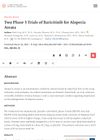TLDR JAK inhibitors offer new hope for treating severe alopecia areata.
Janus kinase (JAK) inhibitors have significantly advanced the treatment of moderate-to-severe alopecia areata (AA), a condition that has been difficult to treat historically. The approval of baricitinib and ritlecitinib, with deuruxolitinib nearing approval, highlights this progress. Phase 3 clinical trials demonstrated that baricitinib resulted in ≤20% scalp hair loss in 39% and 23% of patients at 4 mg and 2 mg doses, respectively, over 36 weeks. Ritlecitinib showed similar results in 23% of patients at 50 mg over 24 weeks, increasing to 40% over 48 weeks, while deuruxolitinib showed 30%-42% efficacy over 24 weeks. These results emphasize the potential of JAK inhibitors in managing AA, although topical JAK inhibitors have not been effective for moderate-to-severe cases.
 148 citations
,
March 2022 in “The New England Journal of Medicine”
148 citations
,
March 2022 in “The New England Journal of Medicine” Baricitinib was effective in treating alopecia areata in two major trials.
 12 citations
,
August 2020 in “JEADV. Journal of the European Academy of Dermatology and Venereology/Journal of the European Academy of Dermatology and Venereology”
12 citations
,
August 2020 in “JEADV. Journal of the European Academy of Dermatology and Venereology/Journal of the European Academy of Dermatology and Venereology” Azathioprine is the most continued treatment for chronic alopecia areata over a year, often with added low-dose prednisolone.
 23 citations
,
September 2019 in “Journal of The American Academy of Dermatology”
23 citations
,
September 2019 in “Journal of The American Academy of Dermatology” Tofacitinib and oral minoxidil together effectively regrow hair in severe alopecia areata patients.
 48 citations
,
November 2017 in “Journal of the American Academy of Dermatology”
48 citations
,
November 2017 in “Journal of the American Academy of Dermatology” Tofacitinib 2% ointment helped hair regrow in 3 out of 10 patients with alopecia areata, but caused side effects like scalp irritation and raised cholesterol in some.
 185 citations
,
June 2014 in “Journal of Investigative Dermatology”
185 citations
,
June 2014 in “Journal of Investigative Dermatology” A man with severe hair loss and skin disease regrew his hair with no side effects after taking tofacitinib.
286 citations
,
August 2007 in “Journal of Clinical Investigation” Alopecia areata is an autoimmune disease where T cells attack hair follicles.
 April 2019 in “International journal of research in dermatology”
April 2019 in “International journal of research in dermatology” A child with rough nails also had hair loss and allergies.







